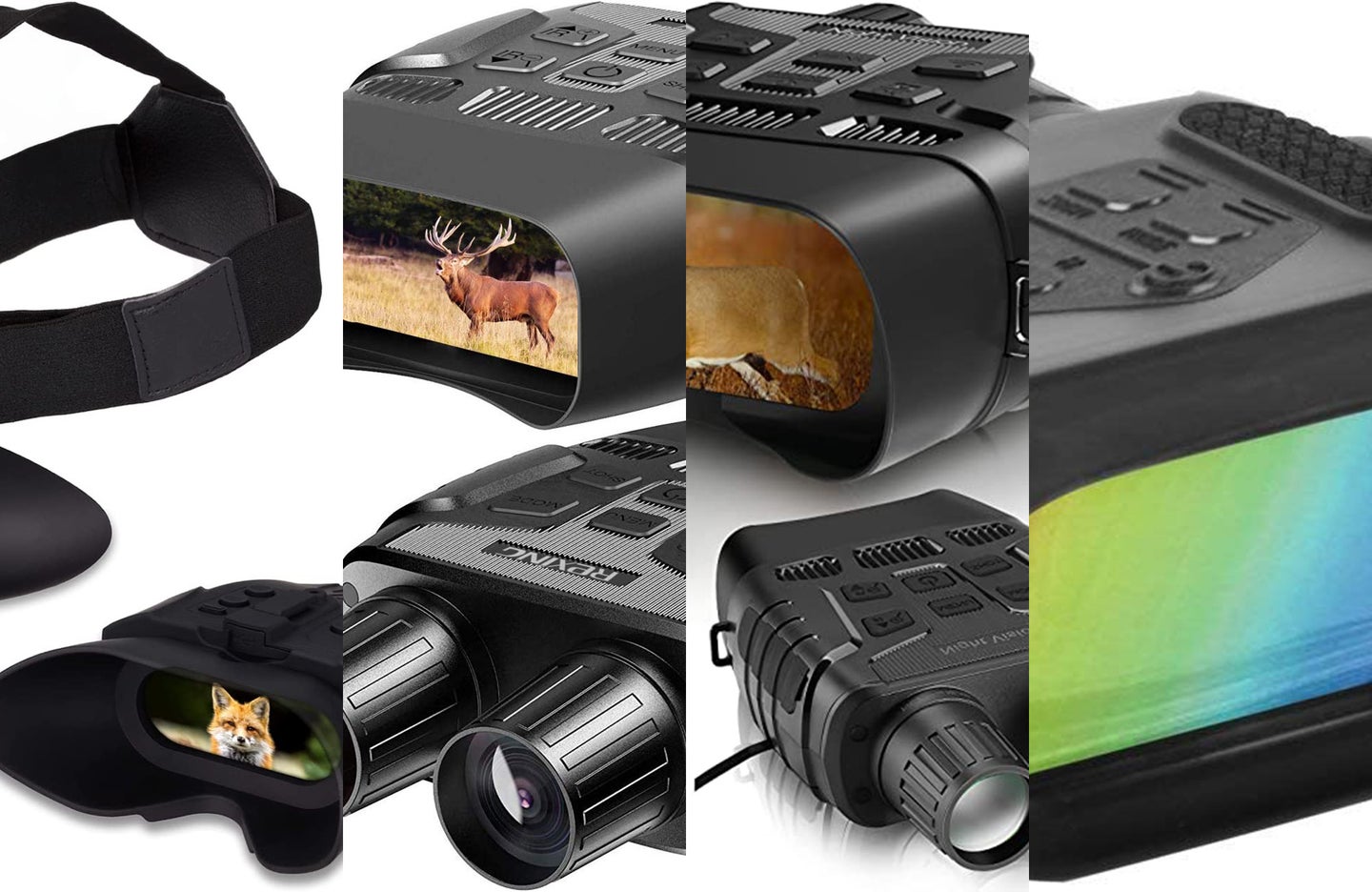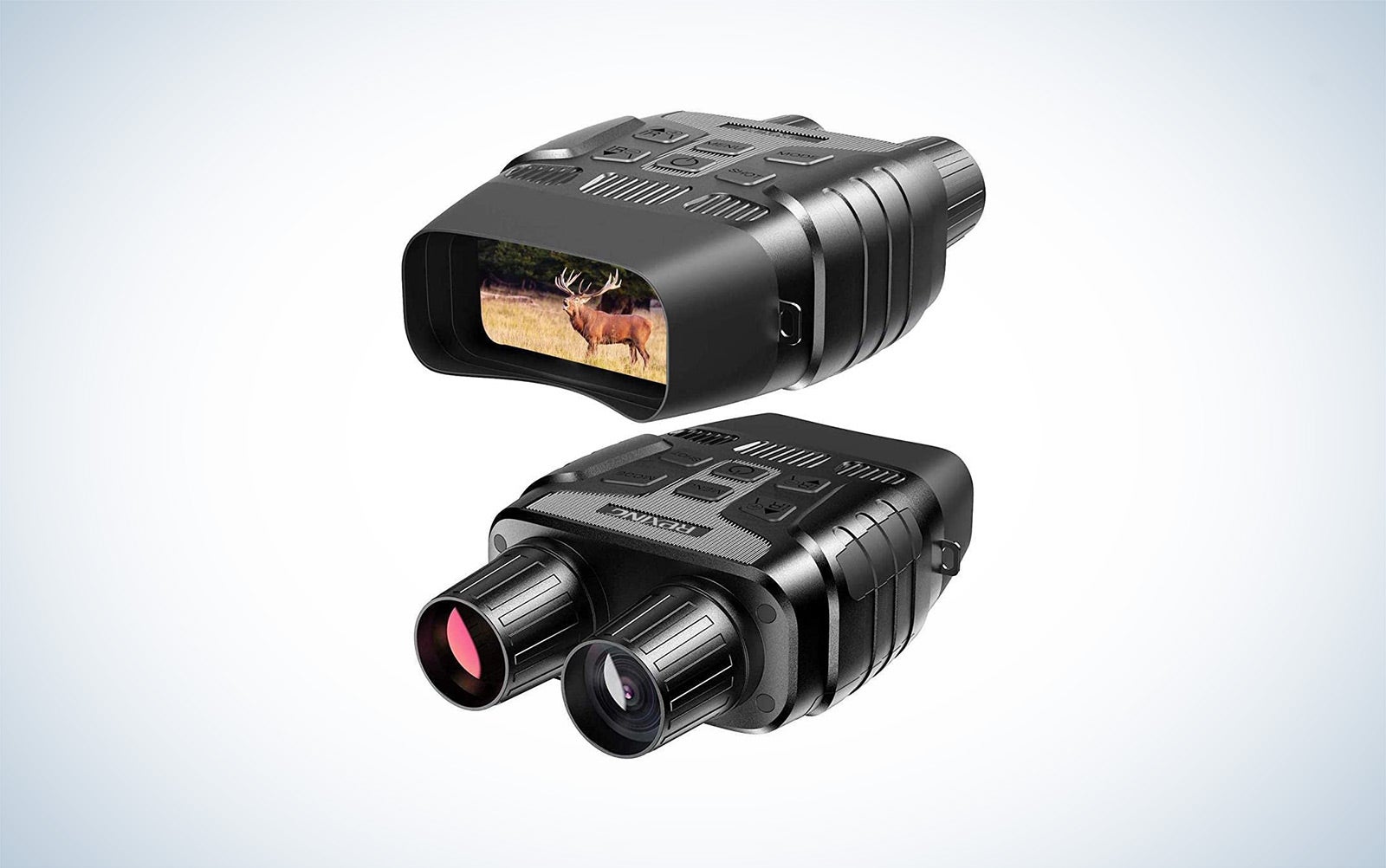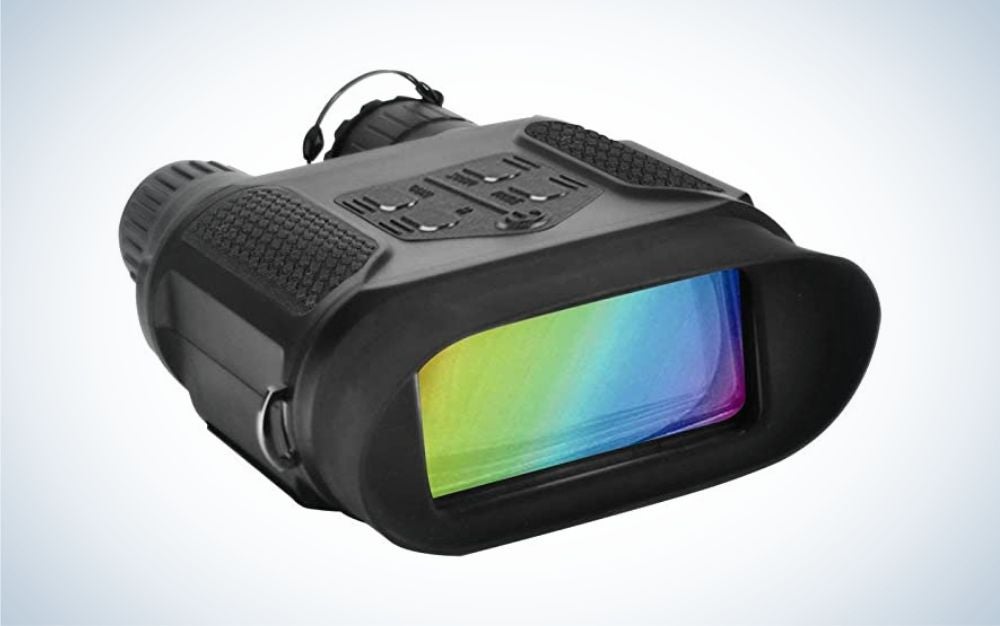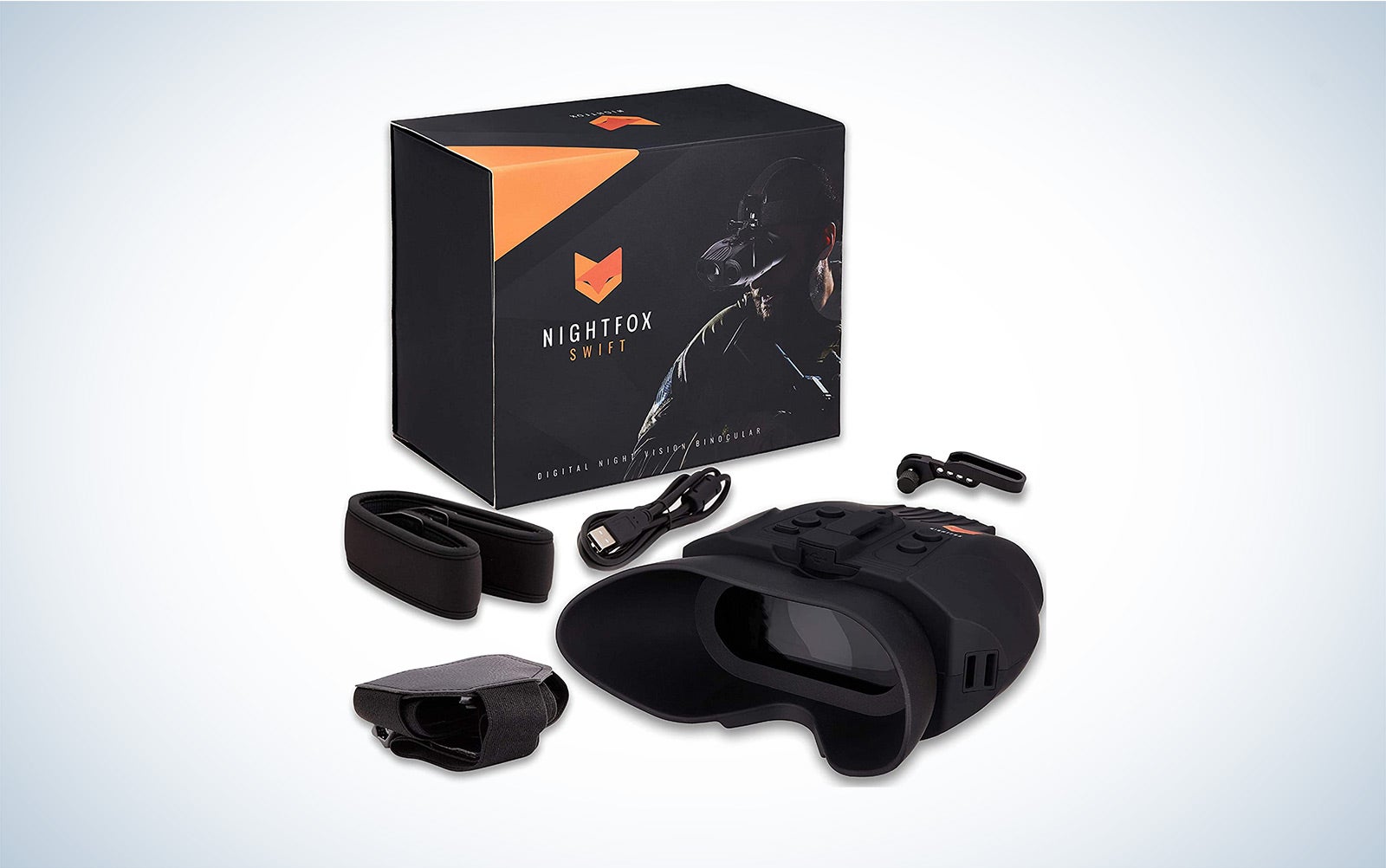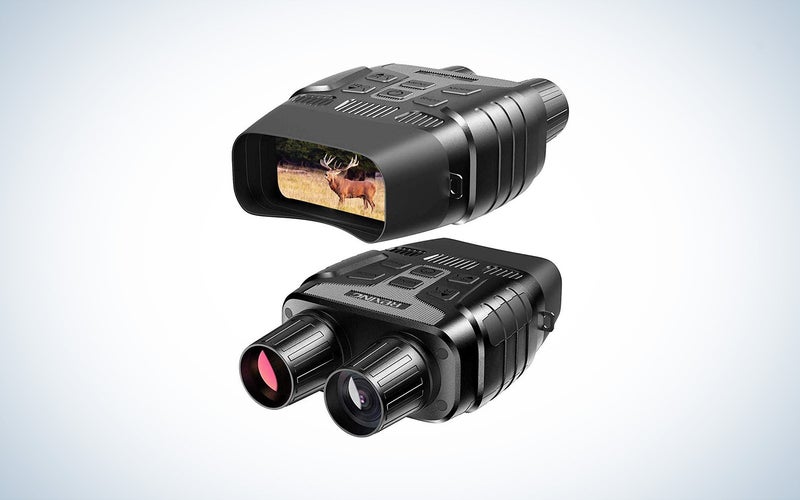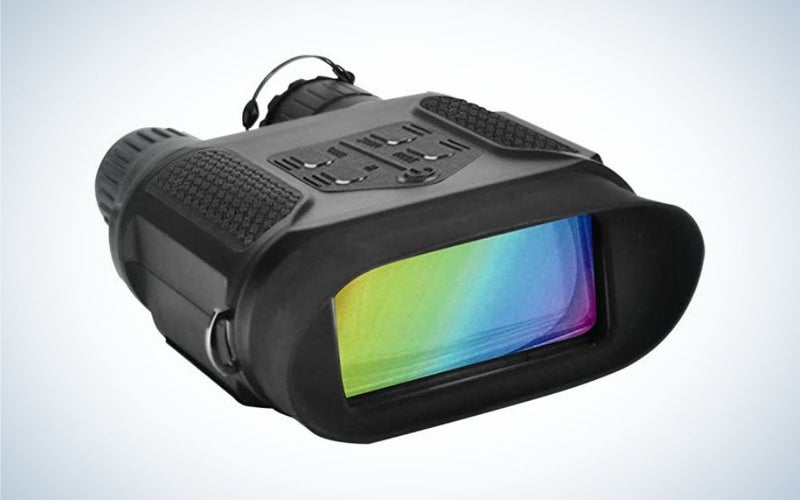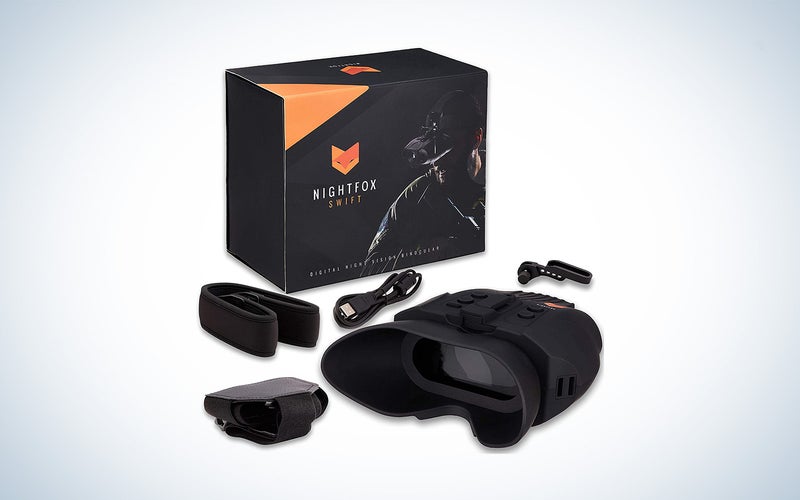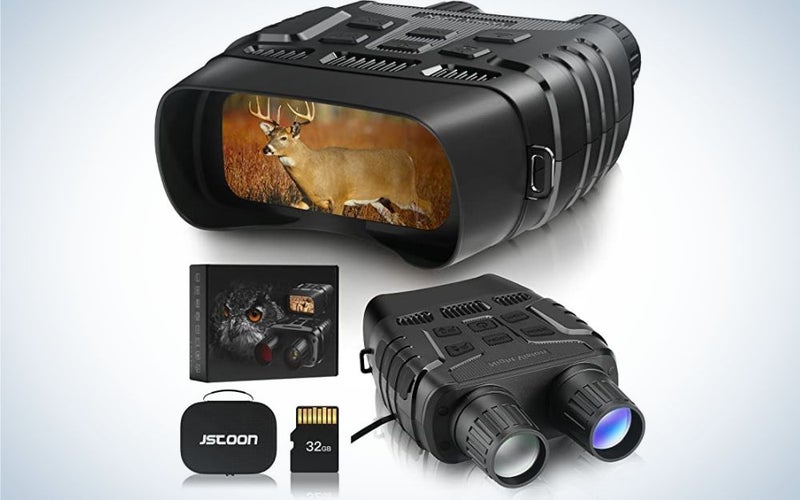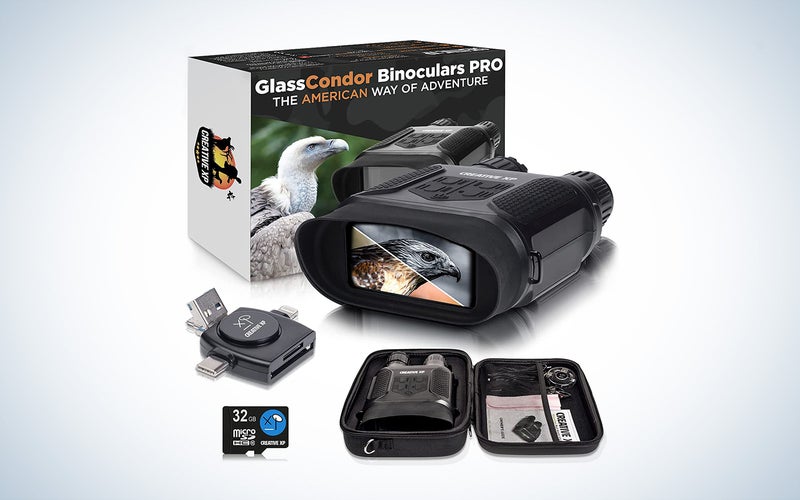We may earn revenue from the products available on this page and participate in affiliate programs. Learn more ›
A good set of night vision goggles can illuminate the darkness without letting others know you are out there. They can be helpful whether you are trying to identify an animal, secure your property, or just want to know what’s out ahead or above you in the night.
In the world of night vision, there are a few options, including night vision monoculars, which some prefer for their simpler structure that often comes at a lower price. But nothing beats a set of night vision binoculars for ease of use, natural view, and a wide field of vision. So when it’s time to see what others can’t, flip down or hold up your goggles and see into the night. Whatever you choose, here are the best night vision goggles and some things to consider before you buy.
- Best overall: Rexing B1
- Best for long-distance: Solomark Night Vision
- Best hands-free: Nightfox Swift
- Best video quality: JStoon Night Vision Goggles
- Best for surveillance: CREATIVE XP Night Vision Goggles – Pro
How we picked the best night vision goggles
We scoured the internet to find the best online resources, experts, expert reviews, consumer reviews, and recommendations for night vision goggles for all situations. From there, we collected an extensive list of some of our favorites. We compared them on a number of essential metrics, including cost, coverage, portability, durability, features, connectivity, and ease of use.
We then worked through each night vision goggle to find its strength and weaknesses and crucial metrics to help you find the night vision goggles that will work best for you and your needs, wherever you are in the world.
The best night vision goggles: Reviews & recommendations
Best overall: Rexing B1
Rexing
Why it made the cut: It offers great magnification and impressive battery life at an affordable price.
Specs
- Type of vision: Digital
- Magnification power: 10x
- Battery type: 6 AA
- Weight: 1.3 pounds
- Dimensions: 5 x 5.25 x 2.25 inches
Pros
- Weatherproof and water-resistant
- Impressive magnification
- Includes tripod mounts
Cons
- Not rechargeable
The Rexing B1 is an impressive set of night vision goggles, especially considering the price. These goggles provide 10x optical magnification and 4x digital magnification with an effective range of 300m. You can use one of seven IR settings to fine-tune your brightness as you look near and far. Though some might be unimpressed with the video quality, which comes in at 720p at 30 fps, it is still plenty for the price.
After recording night vision footage, you can play back what you capture on the 2.31-inch screen or use a cable to connect it to your computer or TV. And you’ll have plenty of footage. When used in the daytime, the 6 AA batteries can power these goggles for 17 hours, giving you access to the impressive zoom. In IR night vision mode, it will still last an impressive six hours.
These goggles are ready for whatever your mission is thanks to weatherproofing and IP56 water resistance, which means, while you won’t want to dunk these underwater, you won’t have to come in from the rain.
Best for long-distance: Solomark Night Vision
SOLOMARK
Why it made the cut: These have an impressive effective range, even without supremely high-quality video.
Specs
- Type of Vision: Digital
- Magnification Power: 7X
- Battery Type: 8 AA
- Weight: 2.2 pounds
- Dimensions: 12 x 10 x 5 inches
Pros
- Expansive 1300ft range
- Easy to use
- Day and night functionality
- Clear and bright LCD screen
Cons
- Requires a lot of batteries
- Lower quality video
This set of night vision goggles has an impressive 1300ft range with multiple magnification settings ranging from 3.5 to 7X, making it a great option for many who need long-range sight at night.
The infrared illuminator will light up even the darkest nights and make them easily viewable with the internal 4-inch viewing screen and the option to wire the goggles to an external viewing screen like a TV or computer. Some might not be impressed with the end video quality, though, as 720p with 30fps viewing can leave some images blurry.
These goggles are easy to use and adjust between three brightness and three IR settings. Or you can use them during the day with the IR fully turned off. To make things easier, it comes with a microSD card.
The Solomark has easy-to-hold grip surfaces, though prolonged use might be difficult as it requires a lot of batteries which adds considerable weight.
Best hands-free: Nightfox Swift
Nightfox
Why it made the cut: Thanks to the included head mount, they are hands-free, easy to use, and simple.
Specs
- Type of Vision: Digital
- Magnification Power: 1x
- Battery Type: Rechargeable
- Weight: 11.81 ounces
- Dimensions: 6.69 x 5.51 x 2.76 inches
Pros
- Hands free operation
- Lightweight
- Integrated battery
Cons
- Can be disorienting with long usage
- No magnification
The Nightfox Swift is a great entry-level product for those who want to see at night, especially in close range. But, unlike many other night vision goggles, these do not provide any magnification and have an admittedly limited effective range of about 75 yards. As a result, these are best for nearby viewing, like home security or moving through a dark area without needing to know what is far off in the distance.
You can use these goggles hands-free thanks to pre-equipped headgear. It lets your night vision easily move with you. Adjustments to brightness and IR levels are easily made with simple buttons on the rubberized goggle body. The overall user interface is intuitive and should offer most users few issues.
These goggles are rechargeable with about three hours of battery life. And they are smaller than most other options making them great for travel, so long as you have the ability to recharge them regularly.
Best video quality: JStoon Night Vision Goggles
JStoon
Why it made the cut: They offer great range with no need to buy a memory card.
Specs
- Type of Vision: Digital
- Magnification Power: 4X
- Battery Type: 6 AA
- Weight: 1.3 pounds
- Dimensions: 10.2 x 7.9 x 3.6 inches
Pros
- Comes with a 32 GB card
- Impressive image quality for the price
- Long range viewing
Cons
- Short battery life
These goggles have an impressive range and image clarity, with the benefit of surprising accessories included. They are great night vision goggles for those who need long range thanks to their effective distance of 984 feet in complete darkness. And you can adjust the IR emitter for variable light conditions, including daytime. With that distance, you will also get 960p 30 fps resolution video which you can export to a computer or TV with the included cable.
The 25mm objective lens is less impressive than some of the other night vision goggles we saw but still gets the job done. We have seen better battery life, though, as six AA only works for about six hours of operation.
These goggles offer manual focus and a 2.31-inch screen for easy and clear viewing and even come with a surprising addition of a 32 GB memory card and case. Unfortunately, though, this system is relatively large, so it won’t be ideal for holding by hand for long periods.
Best for surveillance: CREATIVE XP Night Vision Goggles – Pro
Creative XP
Why it made the cut: They provide excellent range, great zoom, and include a memory card.
Specs
- Type of Vision: Digital
- Magnification Power: 7X
- Battery Type: 8 AA
- Weight: 2.86 pounds
- Dimensions: 10.9 x 7.9 x 3.7 inches
Pros
- Comes with a 32 GB card
- Large viewing screen
- Impressive viewing range
Cons
- Less than impressive battery life
- Requires a lot of batteries
- Heavy
The Creative XP Night Vision Goggles offer an impressive viewing range of 1,340 feet thanks to its 31mm objective lens. Combine that with an IR illuminator and a 4-inch viewing screen, and you have long-range, easy-to-view images at night.
The Creative XP also features an impressive 2x digital zoom and 3.5-7x optical zoom which is easy to switch through thanks to the on-goggle zoom adjustment button.
With an IPX4 water resistance rating, it is ready for your outdoor adventures like hunting, night hiking, and scanning for potential predators or intruders. Though you’ll want to ensure the rest of your pack is light, as with eight batteries, these goggles aren’t lightweight. They have impressive visual performance, but using them will require a lot of batteries and strength to hold the associated weight.
Many will be delighted to find these night vision goggles come with a 32GB memory card for recording and storing what you see.
Things to consider before buying night vision goggles
There is a fair amount of technical jargon and numbers mentioned in the product information for night vision goggles. It can be confusing to know what everything means or what is relevant to you. Much of the information relevant to night vision goggles also pertains to choosing binoculars, so if you know those tools, you have a head start. Below are some of the most important things to consider before making your purchase.
Weight
If you are carrying this into the backcountry while hiking, hunting, or doing anything else that will have your belongings on your back, weight is an important consideration. Lighter tools are easier to carry, though that weight savings often comes at the cost of lower quality optics, fewer features, or worse battery life.
Size
Similar to weight, the size of your night vision device will dictate how likely you are to bring it with you. Smaller, more compact devices are easier to justify in the cramped space of a backpack or camp bag. However, if you use these at home or from your vehicle, this may not be as much of a consideration.
Magnification power
Night vision can not only light up the night but can often magnify your view like a pair of binoculars to give you a better view off in the distance. Greater magnification often comes at a higher cost and can sacrifice image quality. Some devices will offer digital magnification along with optic magnification, but just like expanding your fingers to zoom in with a phone camera, this often comes with a degradation of the image quality.
If you want magnification but decide you don’t need night vision abilities, pick from one of our favorite binoculars.
Battery power
Seeing at night requires power, and for most of these devices, you won’t be plugging them into the wall. Some night vision devices run on disposable batteries, while others have built-in rechargeable batteries. This can affect prices as well as run time. Some prefer the ease of recharging, while others like to have their night vision run on disposable batteries so that they can easily bring an extra set off-grid when they are unlikely to return to a charging location before the batteries die.
Objective lens
One of the numbers in the name of binoculars or night vision goggles refers to the objective lens size. The objective lens, or effective diameter, is the diameter of the monocular lens. A larger lens will collect more light and enhance the clarity and brightness of your image.
Analog versus digital night vision
Most night vision relies on infrared light outside our visible light spectrum. Analog night vision uses an image intensification tube to amplify the light in an image. Unfortunately, using your analog night vision in bright conditions can ruin the sensitive technology within the device. But they can be more affordable than digital night vision.
Digital night vision converts infrared light to electronic signals. Because of this, digital night vision will be unaffected by daylight since it just converts the light to electrical signals. These often come in three to four generations, with the quality and brightness of the image increasing in each generation. As a result, these images are much sharper and clearer, though they are often more expensive.
You may also find thermal night vision which creates images from the heat these objects let off. However, since this technology is more advanced, it is usually far more expensive than either analog or digital infrared night vision.
Durability
Consider how you will use your night vision. If it will stay in the car or on the porch, something cheaper can work, but if you know you’ll be putting it through the wringer, adding features like a waterproof body can be well worth the cost.
Cost
As with any purchase, cost will likely be the main factor. Consider the things you need, like magnification power, features, and battery life, as you make your purchase to get the most out of your money. Entry levels can be found under or near $100, while more advanced models easily run deep into the thousands.
FAQs
Q: How much does night vision cost?
Night vision can run the gambit of costs, from a little more than $100 to nearly $1,000 and more. Of course, like with most things in life, you’ll likely get what you pay for. While cheap night vision may give you some visibility, it will probably lack clarity, detail, and durability. Decide what you need, and invest in the proper strengths.
Q: Is night vision worth it?
Whether night vision is worth it depends on your use. If you need night vision for frequent use and have a few use cases you will use it for, then very likely. On the other hand, if you are just curious about the technology, try starting with a cheaper option until you need an upgraded model.
Q: How far can you see with night vision?
The range of night vision goggles depends on how good the magnification is and how good the night vision is at capturing light. Most will work well in short range, while some will work up to 1,000 feet away.
Q: Can you stargaze with night vision?
Night vision amplifies light in the night, so pointing it at the sky will allow you to notice stars and features, like the Milky Way, that may otherwise be impossible to see.
Final thoughts on the best night vision goggles
- Best overall: Rexing B1
- Best for long-distance: Solomark Night Vision
- Best hands-free: Nightfox Swift
- Best video quality: JStoon Night Vision Goggles
- Best for surveillance: CREATIVE XP Night Vision Goggles – Pro
For those looking to have a better view at night through a wide field of vision, hands-on or hands-free for uses like camping, fishing, hunting, security, star gazing, or anything else, night vision gives visibility where you wouldn’t get it otherwise.
The best night vision goggles provide a natural feeling view, the ability to record, and in some cases, magnification, to make your life at night that much easier.
Why trust us
PopPhoto has a long history of delivering the opinions of some of the sharpest and most prolific camera dorks the world has to offer. Since 1937, we’ve been reviewing cameras, providing wisdom from well-known photographers, and generally just nerding out about all that goes into making great pictures. Our current crop of writers and editors have decades of professional photography and camera writing experience among them. Collectively, we’ve probably shot with just about every camera and lens combo you can imagine—as well as some obscure stuff you may not even know about. Remember the Casio Tryx folding camera? PopPhoto does.
We also get that buying a camera is a big decision, which is why we’re dedicated to helping folks choose the right one (or, in our case “ones”) for their needs. Case in point: Handing over top dollar for an expensive rig may leave you unsatisfied if it doesn’t fit your preferred shooting style. Sure, a $6,000 sports-oriented DSLR can capture landscapes, but do you really need to do it at 30 frames-per-second? No, you don’t.
